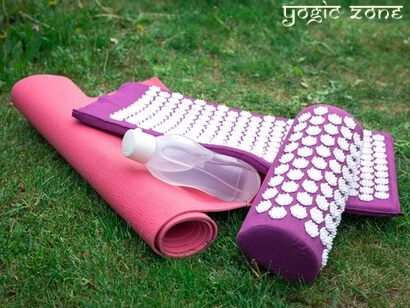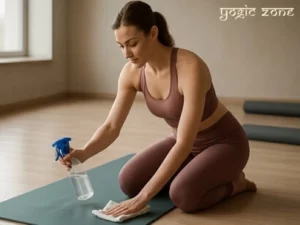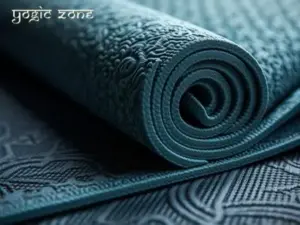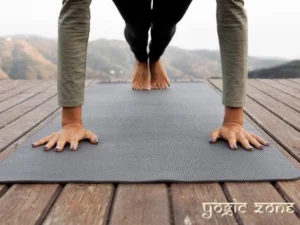
Certified Yoga Teacher with a 900-hour Advanced Teachers Training | Diploma in Yoga from Mumbai University | Individual and group Yoga Trainer, Therapist, Counsellor, and Meditation Coach. Know more about Chintan Mehta.
Choosing your first yoga mat can be confusing. With dozens of options in mat material, thickness, grip, and portability, it’s easy to get confused. Even I was totally lost when I started practicing yoga years ago! As a certified yoga instructor in India, I have helped hundreds of students pick their first mat, and I will make it simple for you and guide you exactly on what to look for in a yoga mat.
What to Look for in a Yoga Mat – At a Glance
| Feature | What to Look For | Best For | |
|---|---|---|---|
| 1 | Material | PVC, TPE, Rubber, Cork, Cotton – each offers different grip, feel, and eco impact | Beginners, eco-conscious users, traditional styles |
| 2 | Thickness & Cushioning | 3–4mm standard, 5–6mm for joint comfort, 1–2mm for travel mats | Home practice, sensitive joints, travel |
| 3 | Grip & Texture | Sticky surface, textured patterns, open/closed-cell construction | Sweaty hands, dynamic styles, beginners |
| 4 | Portability | Lightweight, foldable, includes strap or bag | Class-goers, frequent travelers |
| 5 | Price & Budget | Mid-range mats offer durability and grip without high cost | Beginners seeking value |
What is the Purpose of a Yoga Mat?
A yoga mat provides a stable, non-slip surface that supports safe movement and balance during practice. It cushions your joints, defines personal space, and helps maintain hygiene, especially in shared or outdoor settings. It is a good idea to read about the important yoga mat benefits.

1. Yoga Mat Material: The Foundation of Your Mat
Selecting the right yoga mat material is important, as it affects everything from its feel to its durability and environmental impact. Many people ask me, “What material is best for yoga mats in India?” Here is my list of the most common types of yoga mats:
- PVC (Vinyl): Often the most affordable and durable option. PVC mats are known for their “sticky” feel, which provides excellent grip.
- TPE (Thermoplastic Elastomer): This is a lightweight, recyclable material that offers a good balance of grip and cushioning.
- Natural Rubber: A popular choice for its great grip and firm cushioning. Natural rubber provides a stable, non-slip surface.
- Cork: This is the most natural and sustainable option. Cork offers excellent grip when wet (great for hot yoga)
- Cotton: Cotton rugs provide a traditional, breathable surface. They are ideal for slower practices and for those who prefer natural fibres.
Check this out if you want to know more about the types of yoga mats.
Do you have any doubts or questions about this article?? Chintan Mehta, the author, would love to hear from you. Send us your question now!
2. Yoga Mat Thickness & Cushioning
Thickness is an important factor to look for in a yoga mat. Mat thickness ranges from thin (1 mm) travel mats to luxurious 8 mm comfort mats. The right thickness is a personal choice, but here’s how to choose based on your needs:
- 3–4 mm: This is the standard thickness. It offers a good balance of cushioning for your joints and stability for standing poses. It’s a popular choice and easy to carry.
- 5–6 mm: If you have sensitive knees, wrists, or a tender spine, or if you practice on hard floors, a thicker mat will provide extra comfort and protection.
- 1–2 mm: These are travel mats designed to be lightweight and foldable. They are not meant to be used on their own but rather spread over a studio mat for hygiene and extra grip.
Note: while a thick mat feels comfortable, too much cushioning can make it harder to find stability in balancing poses.
Want to know what’s the right thickness for your body type? Read in detail about yoga mat thickness.
3. Grip & Texture: Safety and Confidence
Your yoga mat grip is important for safety and confidence, preventing your hands and feet from slipping. When considering what to look for in a yoga mat, pay close attention to its surface texture:
- Sticky Mat Surfaces: Most beginner-friendly mats have a slightly sticky surface to keep you from sliding.
- Textured/Patterned Mats: Some mats have raised or etched patterns that improve grip without feeling rough. This is a great yoga mat feature for sweaty practices.
- Open/Closed Cell Mats: Open-cell mats absorb moisture and sweat, which can provide excellent grip but requires more frequent cleaning. Closed-cell mats repel moisture, making them more hygienic and easier to wipe down.
4. Portability & Storage
If you plan to carry your mat to classes or travel frequently, portability is a key yoga mat feature. Look for:
- Lightweight materials like TPE or cotton.
- Foldable or rollable designs.
- Mats that come with a carrying strap or bag.
5. Price & Budget: Smart Shopping
You don’t need to spend a fortune on your first mat. While high-end brands can be durable and long-lasting, a quality mat in the mid-range price point can serve you well for years. Consider your budget, but don’t sacrifice basic features like good grip and durability, which are crucial for a safe and consistent practice.
My Quick Tips for Indian Beginners
• Don’t just buy because it looks fancy—try it under your feet if possible.
• Look for mats with reviews from actual users in India (weather, sweat, and floor type, all these matter).
• Ask me or your yoga teacher for recommendations—we will advise you.
Do you have more questions? Feel free to ask me. Click on the link at the end of this blog.
Your yoga mat is like a supportive partner. When deciding what to look for in a yoga mat, focus on comfort, grip, and a material that suits your personal values and practice style. You don’t need the most expensive mat—you need the one that helps your yoga practice.
Do you have any doubts or questions about this article?? Chintan Mehta, the author, would love to hear from you. Send us your question now!
Frequently Asked Questions About Knowing What to Look for in a Yoga Mat
Which yoga mat is best for sweaty hands?
Select sticky or textured mats; open-cell mats absorb sweat well.
Thicker mat or thinner mat—which is better for knees?
Thicker mat (5–6 mm) for knee comfort, thinner (3–4 mm) for balance. I suggest that you read this blog on yoga mat thickness before you buy a mat
Is PVC mat safe?
Safe to use, but not eco-friendly. If sustainability matters, look for cork or cotton mats. Read our blog on types of mats to know more.
How do I clean my mat?
Wipe with mild soap and water each week, and let it air dry—do not sun dry! Read our ultimate guide to yoga mat cleaning.



